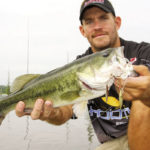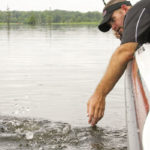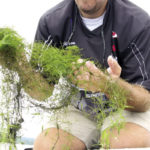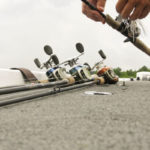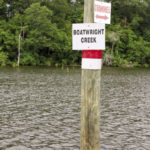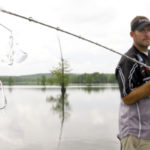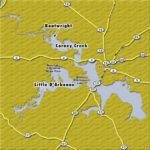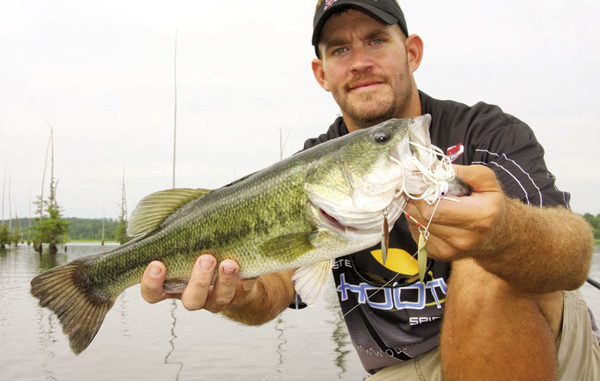
If you can pick your days, you’ll have all the bass action you can stand this month on Lake D’Arbonne.
Chris Burnham hadn’t fished his home lake in over two months. The owner of Old River Lure Company had been out on the road fishing bass tournaments in East Texas, and he only got to see Lake D’Arbonne out the window of his shop while he packaged his company’s Mister Hooty spinnerbaits between events.
I’ve always heard that when you make fishing your business, you are left with very little time to fish. And, aside from tournament fishing, which is an entirely different kind of fishing, it was safe to say that Burnham had very little time to fish.
Burnham was just about burned out.
To make matters worse, the only trip he had this summer where he could just relax and enjoy himself was planned to take place around D’Arbonne’s deep channels in the main lake below the Highway 33 bridge.
Most anybody that has fished the D’Arbonne channels before will tell you this isn’t the most relaxing kind of fishing. In fact, it’s hard work cranking DD22s and pulling 1-ounce Carolina rigs all day in deep water with not a sliver of shade around.
I think that’s why Burnham was so quick to give in to my request to head to the upper end of the Corney Creek arm of the lake and fish a sprawling cypress-tree and grass flat known as Boatwright Creek.
I don’t know if he thought we would actually catch any bass, but he seemed comforted by the thought of throwing topwaters, spinnerbaits and soft jerkbaits in shallow water rather than dredging the deep all day long.
“We’ll start back here on the edge of the grass for a little while,” he said while idling past the Boatwright Creek sign on the outside turn of a 90-degree channel bend. “Frogs, buzz baits, whatever, but then we’re going to have to back out and hit the channel to work for a good bite.”
Dang, he just couldn’t get work out of his mind. It was time for Burnham to take the advice my grandfather proudly displayed on a plaque in his hall, “When work interferes with fishing, quit work!”
It was time for Burnham to relax.
I followed up Burnham’s white buzz bait with a Stanley Ribbit as we skirted the edges of the grass in the far back end of Boatwright Creek. Try as we might to get even farther back into the shallow pockets, we just couldn’t because the trolling motor propeller kept getting wrapped in gobs of grass.
A quick survey of the situation revealed the difference between those of us who just go fishing and those of us who actually catch fish. Burnham noticed that the water seemed to be lower than normal, and he theorized that we weren’t going to catch anything at the back of this flat.
Turning and pointing toward the winding channel some 200 yards away, he said matter-of-factly, “We’ll find them somewhere between here and there. Bass aren’t going to stay back here with the water falling out. I’ll bet you we find a little 3- or 4-foot depression between here and the channel that is loaded with bass.”
Almost immediately, a bass sucked down Burnham’s buzz bait. It wasn’t very big, but it was a good sign that we were at least headed in the right direction. The farther we got away from the back of the flat, the more bites we got.
At first, it was one bite here and one bite there, but then the pile of bass that Burnham had predicted gave themselves away as they slashed into shad on the surface. Because of a hump that topped out just under the water, we couldn’t get within casting range.
“So much for the stealth approach,” Burnham said as his trolling motor propeller chopped the surface of the water. “If we can get to the other side of this hump, though, I think we’ll be in good shape — got to be at least 3 or 4 feet over there.”
The difference was obvious on the depth finder as we circled around the small hump. On the other side was a slight depression that dropped down to 4 feet. Bass were apparently hanging out in the deeper water and running up on the hump to feed as shad made the mistake of swimming through the constricted water.
Anglers that we are, we took advantage of the situation by making sure bass mistook our buzz baits, Yellow Magic poppers, Rat-L-Traps and soft jerkbaits for real food, and we caught and released several 1- to 2-pound bass.
Not satisfied with the size of the bass we were catching, Burnham thought we could catch even bigger fish if we found this same kind of spot even closer to the channel. We had only been fishing for a couple hours, and increasing cloud cover made it easy to make the decision to stick with the shallow flat rather than head downlake to the deep water.
Now, don’t get me wrong. We were moving toward the channel, but we weren’t going to fish the channel. There is a big difference between fishing the abrupt drop-off associated with the edge of the channel and the flat that leads to the drop.
As it is in Boatwright Creek, the farther up you go into the two main D’Arbonne channels, Little D’Arbonne and Corney Creek, the shallower the flats on either side of the channel. Everything kind of compresses in the far reaches of the creeks, and it’s not unusual to fish a 3-foot flat right next to a 20-foot channel.
We hadn’t moved very far when we stumbled upon the same kind of scenario we had just fished. Only, this time, bass were feeding on the edges of a 1-foot hump that was about 50 yards from the channel rather than 150 yards.
And as surely as he had predicted, Burnham landed our largest bass of the day. The 4-pounder swallowed his white buzz bait just as it churned across the edge of the hump and into 3-foot water around it.
The rest of our trip was spent on this shallow flat. We wound up with three productive areas, and we rotated between them to allow each spot to rest and replenish with fish.
Rain eventually ran us off the water, and Burnham explained as we idled toward his boat dock that this wasn’t the first time he had caught shallow bass all day long during the summer.
“During September, especially, it’s going to be a shad pattern everywhere you go on this lake,” he explained. “Find concentrations of baitfish and figure out what has those baitfish where they are.
“Take today, for example. The bait wasn’t scattered all over the flat. They were concentrated on areas with grass that dropped off into deeper water. Any time that bait swam over this edge, the bass ambushed them. During September, you could run that pattern all day all over the lake.”
The lures that Burnham uses depends on what kind of fishing he’s doing. If he’s just out having a little fun, he would tie on a Rat-L-Trap and catch 100 a day. However, if he were fishing a bass tournament, he would stick with a buzz bait or a Yellow Magic topwater popper.
Regardless of what he throws, Burnham breaks down a flat based on the water level and temperature. The higher and cooler the water, the farther he’ll go to the back of a flat. And the lower and warmer the water, the closer he’ll move to the channel.
“Then I look for those key little areas where I keep seeing fish move in the same spot over and over,” Burnham said. “Bass repeatedly blowing up on the same spot tells me that it’s not a fluke of a fish just jumping somewhere. There’s something there holding them.”
Although the bite could last all day long in cloudy weather, Burnham says the best bite shallow is only going to last the first hour or two of the morning. You can go in there early and catch a couple big fish that are cruising around, but after the sun comes up and it gets hot, you’re going to have to go to the channel.
Therefore, if you don’t want to do time on the channel, pick your days during September to be able to stay shallow all day long. Cloudy days are best, and just a light, misting rain would be ideal during September.
“But by the end of the month and early October, you’ll be able to stay shallow all day long no matter what the weather is like,” Burnham said. “Then, you’ll be able to catch fish all over D’Arbonne doing just about anything you want to do. If you want to rush the October free-for-all, pick out a cloudy September day.”
Burnham found that fishing a shallow flat when all logic told him he had to go deep was a great way to relieve his pent-up fishing frustrations. Chunking and winding is a little easier on the soul than pulling and dragging, and it doesn’t feel anything like
work.
